Impact of Public Policies on Aboriginal Health: Peda Community
VerifiedAdded on 2022/08/31
|5
|1337
|11
Essay
AI Summary
This essay examines the Peda Aboriginal community in New South Wales, Australia, focusing on the impact of public policies on their health and well-being. It highlights the historical context of marginalization and suppression faced by the Aboriginal population, discussing how public policies have contributed to disparities in areas like food, education, employment, and living conditions. The essay explores the social determinants of health, including factors such as access to medical facilities, transportation, and educational institutions, and their influence on the community's health outcomes. It also discusses the role of public policies in addressing food insecurity and promoting equality. The essay concludes by emphasizing the need for continued government support and inclusive policies to improve the health and overall development of the Peda community and the broader Aboriginal population, advocating for more comprehensive strategies to achieve a complete balance between indigenous and non-indigenous communities.
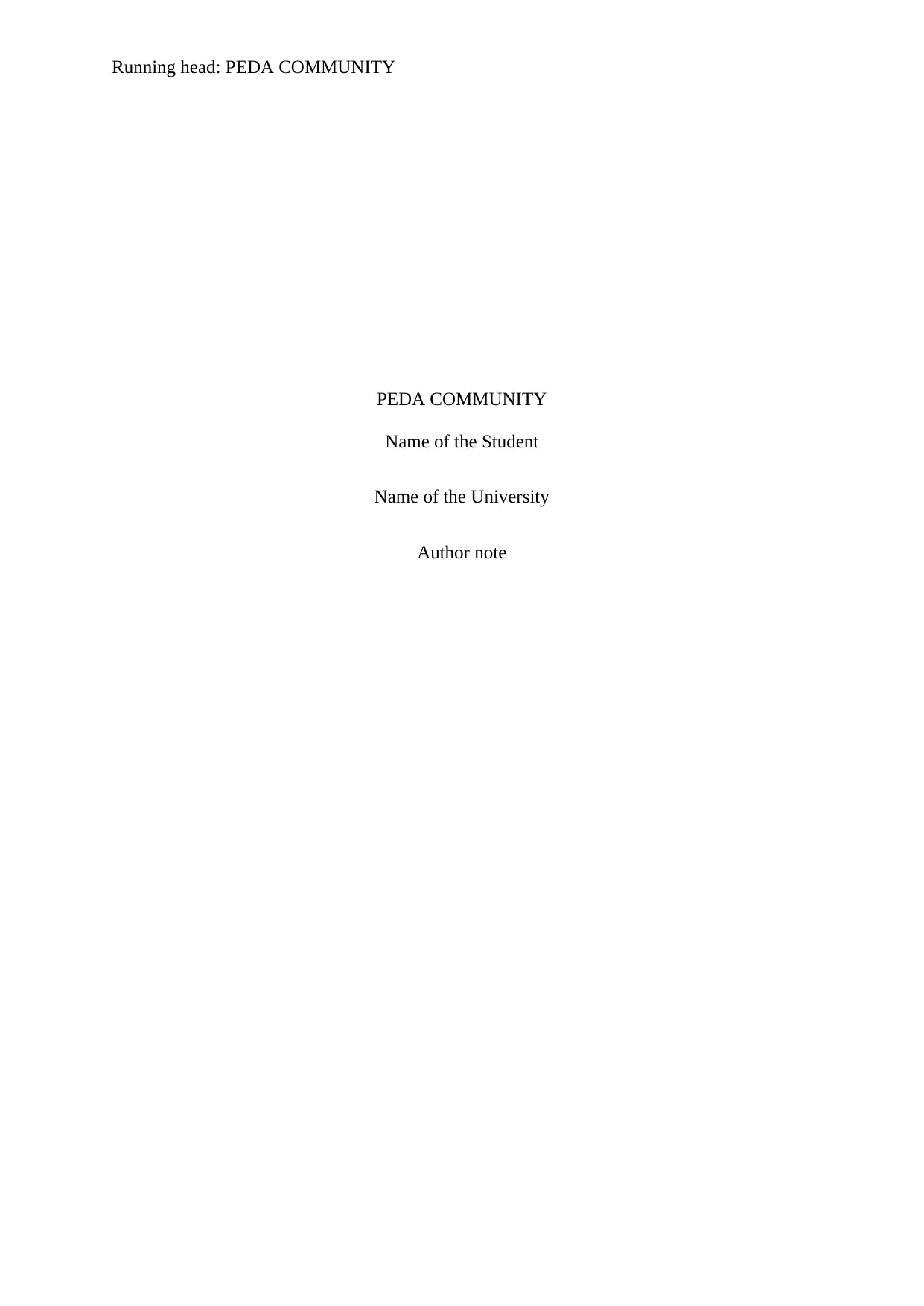
Running head: PEDA COMMUNITY
PEDA COMMUNITY
Name of the Student
Name of the University
Author note
PEDA COMMUNITY
Name of the Student
Name of the University
Author note
Paraphrase This Document
Need a fresh take? Get an instant paraphrase of this document with our AI Paraphraser
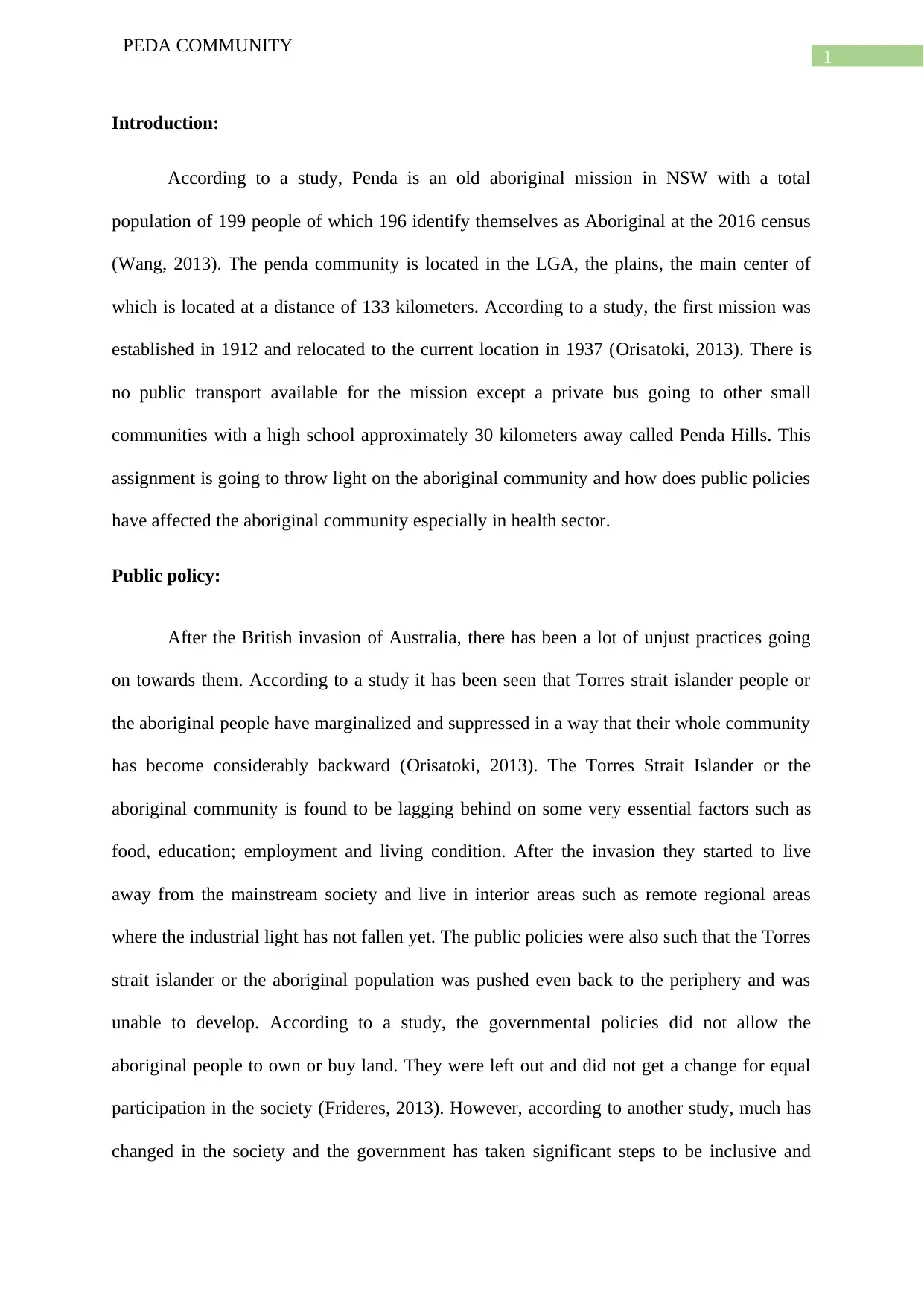
1
PEDA COMMUNITY
Introduction:
According to a study, Penda is an old aboriginal mission in NSW with a total
population of 199 people of which 196 identify themselves as Aboriginal at the 2016 census
(Wang, 2013). The penda community is located in the LGA, the plains, the main center of
which is located at a distance of 133 kilometers. According to a study, the first mission was
established in 1912 and relocated to the current location in 1937 (Orisatoki, 2013). There is
no public transport available for the mission except a private bus going to other small
communities with a high school approximately 30 kilometers away called Penda Hills. This
assignment is going to throw light on the aboriginal community and how does public policies
have affected the aboriginal community especially in health sector.
Public policy:
After the British invasion of Australia, there has been a lot of unjust practices going
on towards them. According to a study it has been seen that Torres strait islander people or
the aboriginal people have marginalized and suppressed in a way that their whole community
has become considerably backward (Orisatoki, 2013). The Torres Strait Islander or the
aboriginal community is found to be lagging behind on some very essential factors such as
food, education; employment and living condition. After the invasion they started to live
away from the mainstream society and live in interior areas such as remote regional areas
where the industrial light has not fallen yet. The public policies were also such that the Torres
strait islander or the aboriginal population was pushed even back to the periphery and was
unable to develop. According to a study, the governmental policies did not allow the
aboriginal people to own or buy land. They were left out and did not get a change for equal
participation in the society (Frideres, 2013). However, according to another study, much has
changed in the society and the government has taken significant steps to be inclusive and
PEDA COMMUNITY
Introduction:
According to a study, Penda is an old aboriginal mission in NSW with a total
population of 199 people of which 196 identify themselves as Aboriginal at the 2016 census
(Wang, 2013). The penda community is located in the LGA, the plains, the main center of
which is located at a distance of 133 kilometers. According to a study, the first mission was
established in 1912 and relocated to the current location in 1937 (Orisatoki, 2013). There is
no public transport available for the mission except a private bus going to other small
communities with a high school approximately 30 kilometers away called Penda Hills. This
assignment is going to throw light on the aboriginal community and how does public policies
have affected the aboriginal community especially in health sector.
Public policy:
After the British invasion of Australia, there has been a lot of unjust practices going
on towards them. According to a study it has been seen that Torres strait islander people or
the aboriginal people have marginalized and suppressed in a way that their whole community
has become considerably backward (Orisatoki, 2013). The Torres Strait Islander or the
aboriginal community is found to be lagging behind on some very essential factors such as
food, education; employment and living condition. After the invasion they started to live
away from the mainstream society and live in interior areas such as remote regional areas
where the industrial light has not fallen yet. The public policies were also such that the Torres
strait islander or the aboriginal population was pushed even back to the periphery and was
unable to develop. According to a study, the governmental policies did not allow the
aboriginal people to own or buy land. They were left out and did not get a change for equal
participation in the society (Frideres, 2013). However, according to another study, much has
changed in the society and the government has taken significant steps to be inclusive and
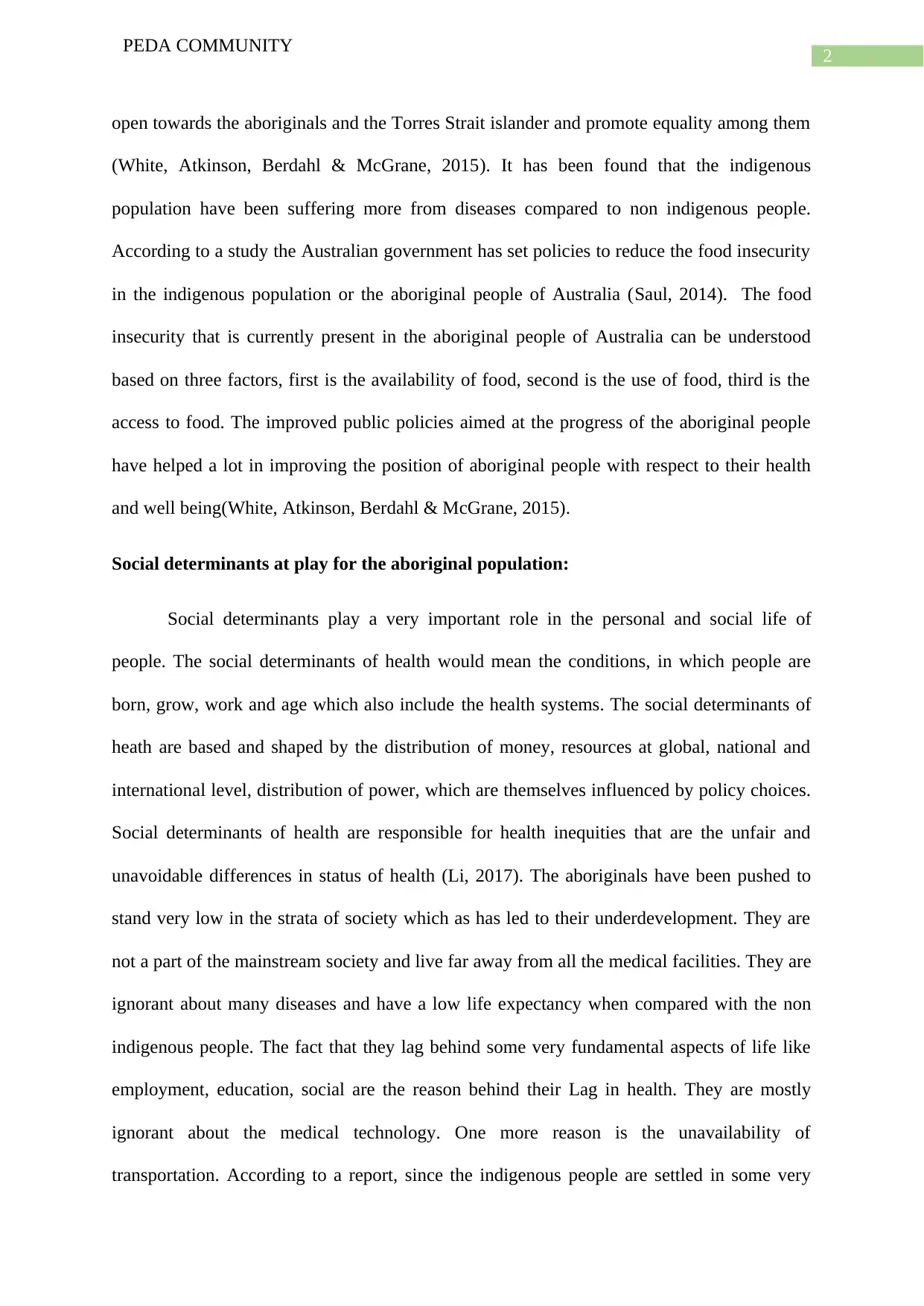
2
PEDA COMMUNITY
open towards the aboriginals and the Torres Strait islander and promote equality among them
(White, Atkinson, Berdahl & McGrane, 2015). It has been found that the indigenous
population have been suffering more from diseases compared to non indigenous people.
According to a study the Australian government has set policies to reduce the food insecurity
in the indigenous population or the aboriginal people of Australia (Saul, 2014). The food
insecurity that is currently present in the aboriginal people of Australia can be understood
based on three factors, first is the availability of food, second is the use of food, third is the
access to food. The improved public policies aimed at the progress of the aboriginal people
have helped a lot in improving the position of aboriginal people with respect to their health
and well being(White, Atkinson, Berdahl & McGrane, 2015).
Social determinants at play for the aboriginal population:
Social determinants play a very important role in the personal and social life of
people. The social determinants of health would mean the conditions, in which people are
born, grow, work and age which also include the health systems. The social determinants of
heath are based and shaped by the distribution of money, resources at global, national and
international level, distribution of power, which are themselves influenced by policy choices.
Social determinants of health are responsible for health inequities that are the unfair and
unavoidable differences in status of health (Li, 2017). The aboriginals have been pushed to
stand very low in the strata of society which as has led to their underdevelopment. They are
not a part of the mainstream society and live far away from all the medical facilities. They are
ignorant about many diseases and have a low life expectancy when compared with the non
indigenous people. The fact that they lag behind some very fundamental aspects of life like
employment, education, social are the reason behind their Lag in health. They are mostly
ignorant about the medical technology. One more reason is the unavailability of
transportation. According to a report, since the indigenous people are settled in some very
PEDA COMMUNITY
open towards the aboriginals and the Torres Strait islander and promote equality among them
(White, Atkinson, Berdahl & McGrane, 2015). It has been found that the indigenous
population have been suffering more from diseases compared to non indigenous people.
According to a study the Australian government has set policies to reduce the food insecurity
in the indigenous population or the aboriginal people of Australia (Saul, 2014). The food
insecurity that is currently present in the aboriginal people of Australia can be understood
based on three factors, first is the availability of food, second is the use of food, third is the
access to food. The improved public policies aimed at the progress of the aboriginal people
have helped a lot in improving the position of aboriginal people with respect to their health
and well being(White, Atkinson, Berdahl & McGrane, 2015).
Social determinants at play for the aboriginal population:
Social determinants play a very important role in the personal and social life of
people. The social determinants of health would mean the conditions, in which people are
born, grow, work and age which also include the health systems. The social determinants of
heath are based and shaped by the distribution of money, resources at global, national and
international level, distribution of power, which are themselves influenced by policy choices.
Social determinants of health are responsible for health inequities that are the unfair and
unavoidable differences in status of health (Li, 2017). The aboriginals have been pushed to
stand very low in the strata of society which as has led to their underdevelopment. They are
not a part of the mainstream society and live far away from all the medical facilities. They are
ignorant about many diseases and have a low life expectancy when compared with the non
indigenous people. The fact that they lag behind some very fundamental aspects of life like
employment, education, social are the reason behind their Lag in health. They are mostly
ignorant about the medical technology. One more reason is the unavailability of
transportation. According to a report, since the indigenous people are settled in some very
⊘ This is a preview!⊘
Do you want full access?
Subscribe today to unlock all pages.

Trusted by 1+ million students worldwide
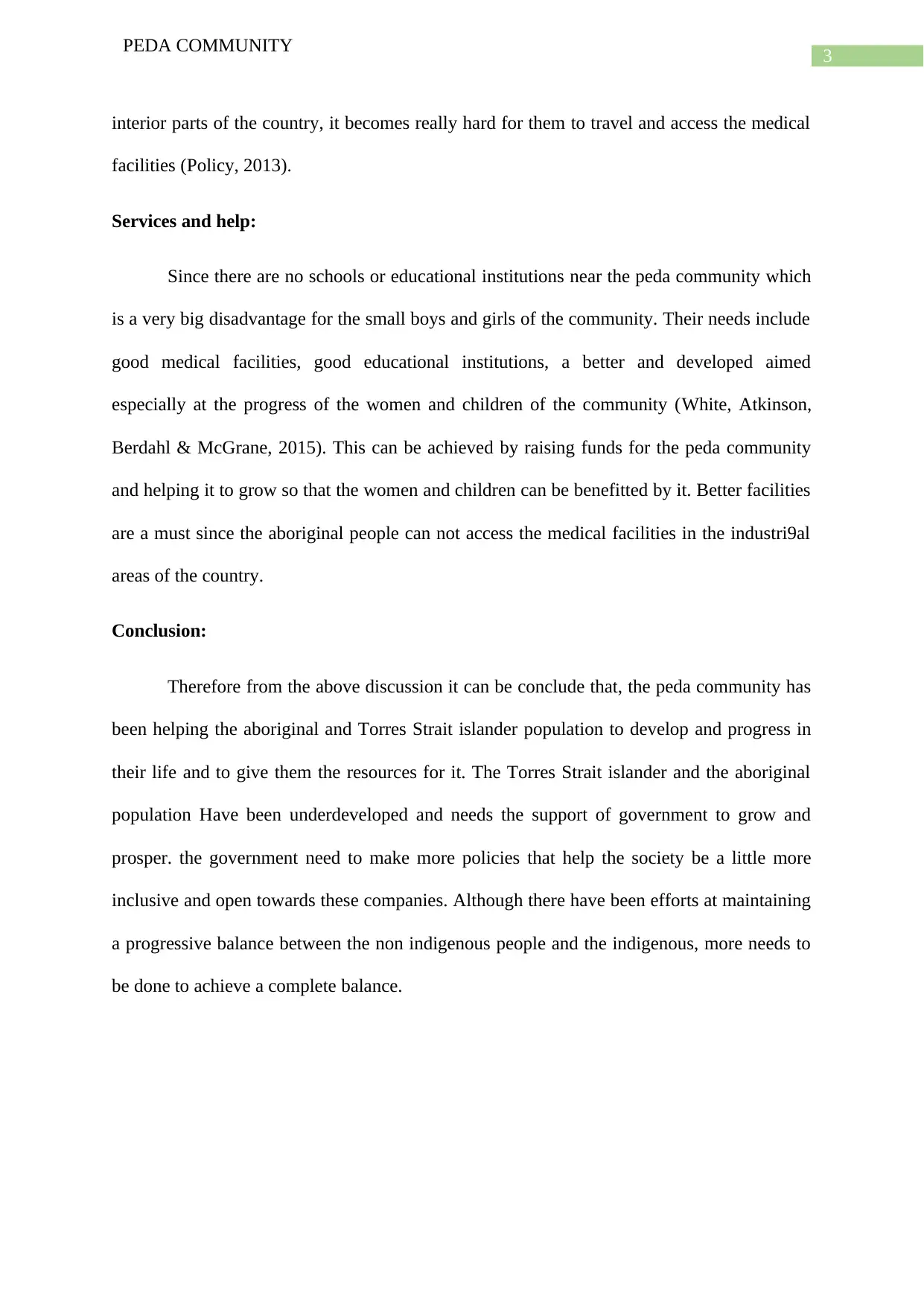
3
PEDA COMMUNITY
interior parts of the country, it becomes really hard for them to travel and access the medical
facilities (Policy, 2013).
Services and help:
Since there are no schools or educational institutions near the peda community which
is a very big disadvantage for the small boys and girls of the community. Their needs include
good medical facilities, good educational institutions, a better and developed aimed
especially at the progress of the women and children of the community (White, Atkinson,
Berdahl & McGrane, 2015). This can be achieved by raising funds for the peda community
and helping it to grow so that the women and children can be benefitted by it. Better facilities
are a must since the aboriginal people can not access the medical facilities in the industri9al
areas of the country.
Conclusion:
Therefore from the above discussion it can be conclude that, the peda community has
been helping the aboriginal and Torres Strait islander population to develop and progress in
their life and to give them the resources for it. The Torres Strait islander and the aboriginal
population Have been underdeveloped and needs the support of government to grow and
prosper. the government need to make more policies that help the society be a little more
inclusive and open towards these companies. Although there have been efforts at maintaining
a progressive balance between the non indigenous people and the indigenous, more needs to
be done to achieve a complete balance.
PEDA COMMUNITY
interior parts of the country, it becomes really hard for them to travel and access the medical
facilities (Policy, 2013).
Services and help:
Since there are no schools or educational institutions near the peda community which
is a very big disadvantage for the small boys and girls of the community. Their needs include
good medical facilities, good educational institutions, a better and developed aimed
especially at the progress of the women and children of the community (White, Atkinson,
Berdahl & McGrane, 2015). This can be achieved by raising funds for the peda community
and helping it to grow so that the women and children can be benefitted by it. Better facilities
are a must since the aboriginal people can not access the medical facilities in the industri9al
areas of the country.
Conclusion:
Therefore from the above discussion it can be conclude that, the peda community has
been helping the aboriginal and Torres Strait islander population to develop and progress in
their life and to give them the resources for it. The Torres Strait islander and the aboriginal
population Have been underdeveloped and needs the support of government to grow and
prosper. the government need to make more policies that help the society be a little more
inclusive and open towards these companies. Although there have been efforts at maintaining
a progressive balance between the non indigenous people and the indigenous, more needs to
be done to achieve a complete balance.
Paraphrase This Document
Need a fresh take? Get an instant paraphrase of this document with our AI Paraphraser
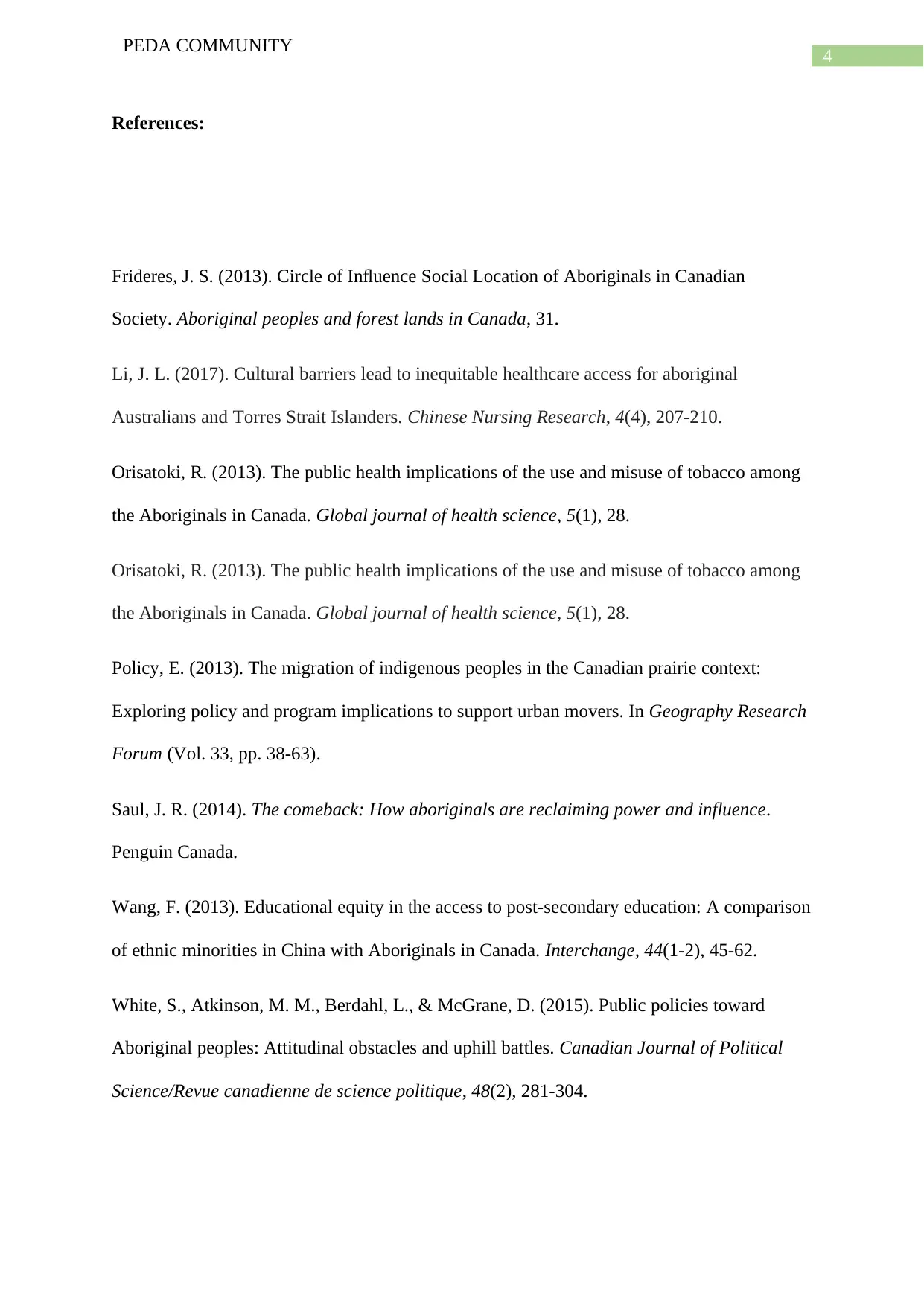
4
PEDA COMMUNITY
References:
Frideres, J. S. (2013). Circle of Influence Social Location of Aboriginals in Canadian
Society. Aboriginal peoples and forest lands in Canada, 31.
Li, J. L. (2017). Cultural barriers lead to inequitable healthcare access for aboriginal
Australians and Torres Strait Islanders. Chinese Nursing Research, 4(4), 207-210.
Orisatoki, R. (2013). The public health implications of the use and misuse of tobacco among
the Aboriginals in Canada. Global journal of health science, 5(1), 28.
Orisatoki, R. (2013). The public health implications of the use and misuse of tobacco among
the Aboriginals in Canada. Global journal of health science, 5(1), 28.
Policy, E. (2013). The migration of indigenous peoples in the Canadian prairie context:
Exploring policy and program implications to support urban movers. In Geography Research
Forum (Vol. 33, pp. 38-63).
Saul, J. R. (2014). The comeback: How aboriginals are reclaiming power and influence.
Penguin Canada.
Wang, F. (2013). Educational equity in the access to post-secondary education: A comparison
of ethnic minorities in China with Aboriginals in Canada. Interchange, 44(1-2), 45-62.
White, S., Atkinson, M. M., Berdahl, L., & McGrane, D. (2015). Public policies toward
Aboriginal peoples: Attitudinal obstacles and uphill battles. Canadian Journal of Political
Science/Revue canadienne de science politique, 48(2), 281-304.
PEDA COMMUNITY
References:
Frideres, J. S. (2013). Circle of Influence Social Location of Aboriginals in Canadian
Society. Aboriginal peoples and forest lands in Canada, 31.
Li, J. L. (2017). Cultural barriers lead to inequitable healthcare access for aboriginal
Australians and Torres Strait Islanders. Chinese Nursing Research, 4(4), 207-210.
Orisatoki, R. (2013). The public health implications of the use and misuse of tobacco among
the Aboriginals in Canada. Global journal of health science, 5(1), 28.
Orisatoki, R. (2013). The public health implications of the use and misuse of tobacco among
the Aboriginals in Canada. Global journal of health science, 5(1), 28.
Policy, E. (2013). The migration of indigenous peoples in the Canadian prairie context:
Exploring policy and program implications to support urban movers. In Geography Research
Forum (Vol. 33, pp. 38-63).
Saul, J. R. (2014). The comeback: How aboriginals are reclaiming power and influence.
Penguin Canada.
Wang, F. (2013). Educational equity in the access to post-secondary education: A comparison
of ethnic minorities in China with Aboriginals in Canada. Interchange, 44(1-2), 45-62.
White, S., Atkinson, M. M., Berdahl, L., & McGrane, D. (2015). Public policies toward
Aboriginal peoples: Attitudinal obstacles and uphill battles. Canadian Journal of Political
Science/Revue canadienne de science politique, 48(2), 281-304.
1 out of 5
Related Documents
Your All-in-One AI-Powered Toolkit for Academic Success.
+13062052269
info@desklib.com
Available 24*7 on WhatsApp / Email
![[object Object]](/_next/static/media/star-bottom.7253800d.svg)
Unlock your academic potential
Copyright © 2020–2025 A2Z Services. All Rights Reserved. Developed and managed by ZUCOL.





